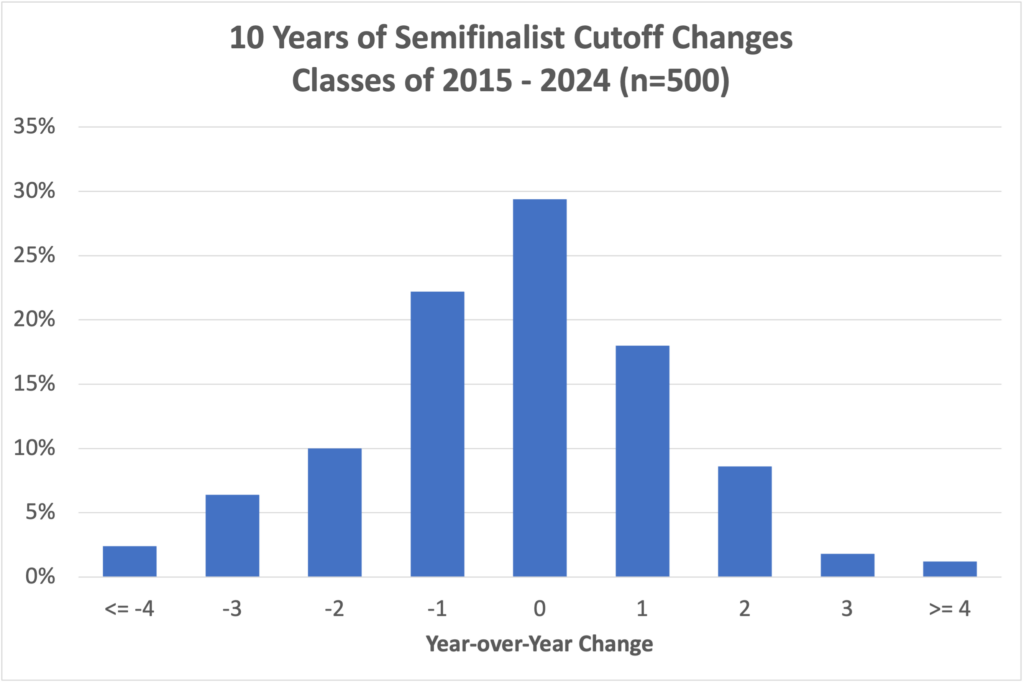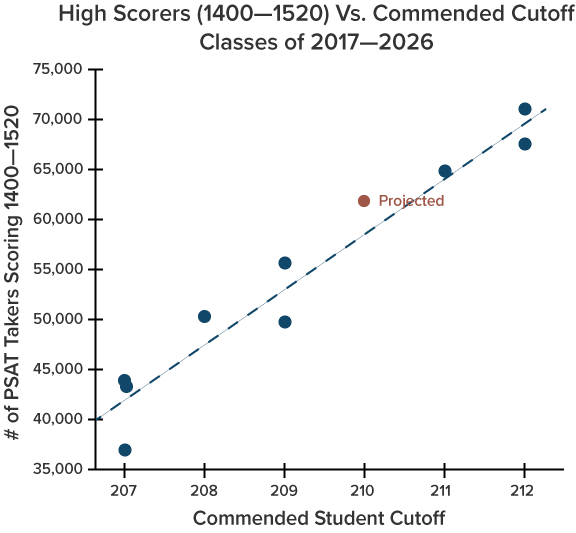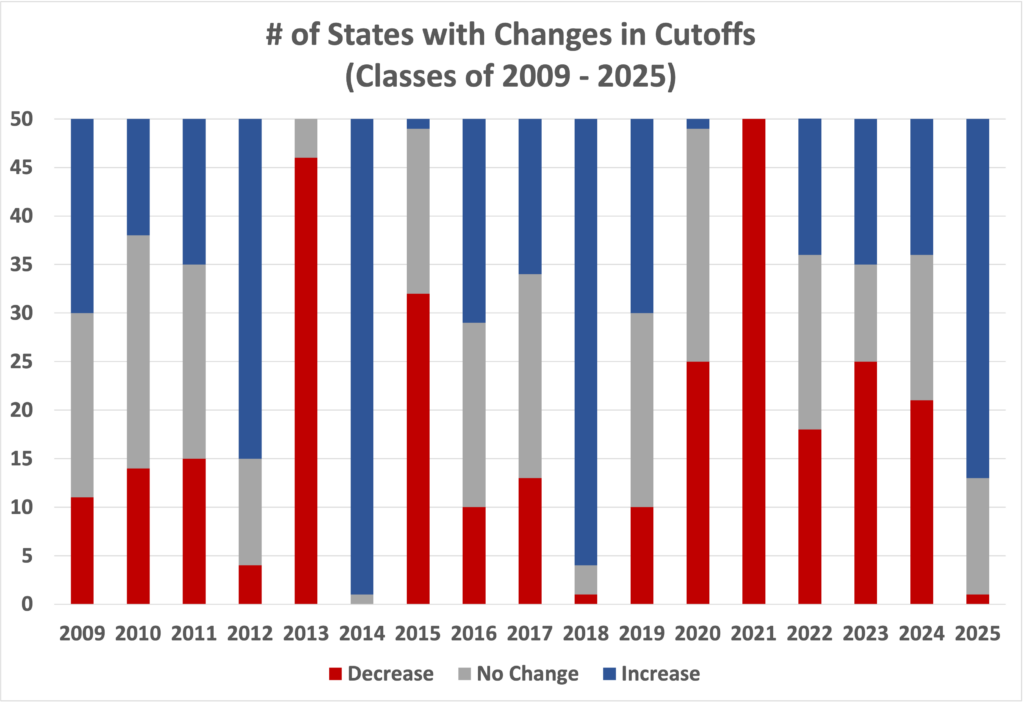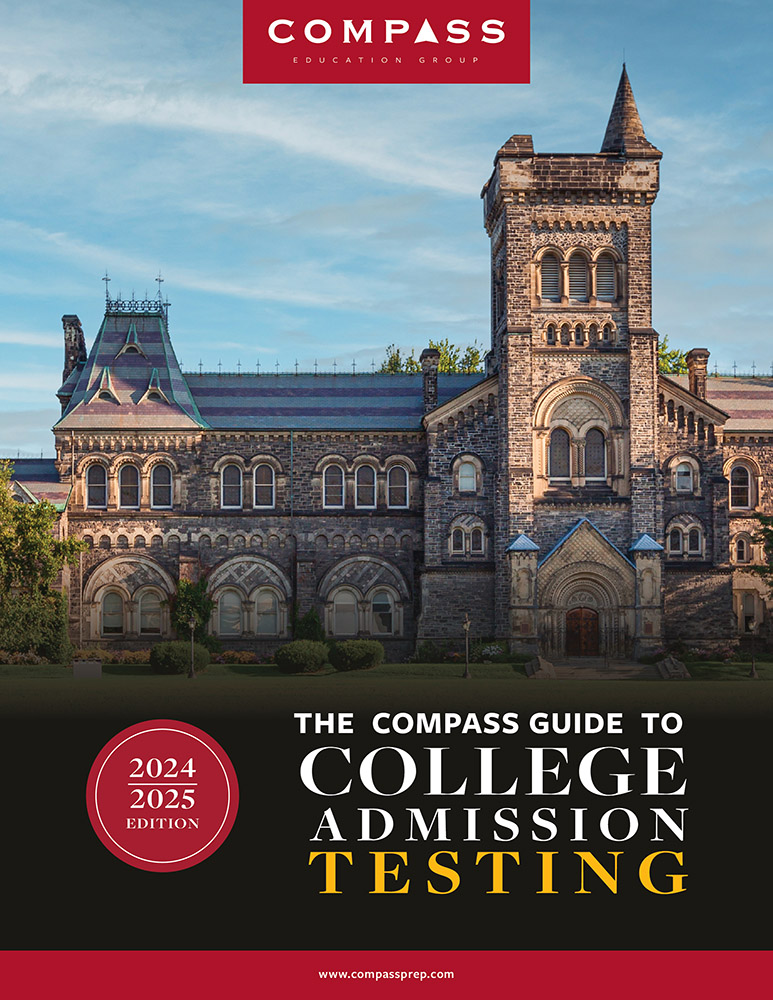
November 13: Updated with final wave of PSAT scores.
College Board released scores in three waves depending on when students took the PSAT. We have now received scores summaries for all three waves. It is possible that some late scores will still dribble in, but we are not expecting any changes. The results point to a strong upward trend in cutoffs for the class of 2026. You are welcome to jump to the table of estimates below, but we encourage students and families to read more about how we came to those estimates. For more information on the National Merit Program, in general, you may want to read Compass’s National Merit Scholarship Program Explained. If you want to browse almost two decades’ worth of cutoffs, you can find them in Compass’s National Merit Historical Cutoffs.
What is a Semifinalist Cutoff?
Each year almost 17,000 juniors are named Semifinalists in the National Merit Scholarship Program and continue on in the hopes of being one of the 15,000 Finalists and, eventually, one of the 7,500 scholarship recipients. The score needed to qualify as a Semifinalist varies by state and is known as the “cutoff.” Every student scoring at or above the Semifinalist cutoff qualifies. The cutoff is not based on a student’s overall PSAT score but on the Selection Index. The Selection Index is listed on a student’s PSAT score report. It can be calculated by doubling the ERW score, adding the Math score, and then dividing the sum by 10. For example, a 720 ERW / 730 M would have a Selection Index of (720 x 2 + 730)/10 = 217. For the class of 2025, cutoffs ranged from 208 to 223.
What is a Commended Student Cutoff?
If you performed well on the PSAT but do not qualify as a Semifinalist, you have the opportunity to be named as a Commended Student. Unlike the Semifinalist cutoffs, the Commended cutoff is set nationally. For last year’s class it was 208. Approximately 36,000 students are named Commended Students each year.
Why does Compass believe that we are likely to see cutoffs, as a whole, go up?
College Board releases very little data about score distribution. The number of top scorers is the most critical piece of information that we get this early in the process. While we do not know the number of students scoring at a particular Selection Index, we do know the number of students scoring in the 1400-1520 range, which roughly correlates to Selection Indexes of 210-228. The class of 2026 ranks 4th in the ten years since the PSAT scoring was overhauled, and this year sees the highest ever percentage of top scores. The number of Semifinalists and Commended students are capped, so cutoffs are likely to rise. But not all cutoffs. The numbers we have seen are at the national level and there is always churn at the state level. What we believe, however, is that more cutoffs will go up than down.
There is a good correlation between the 1400-1520 band of students and the Commended Student score. We believe that the Commended cutoff will come in between 209 and 211, with a 210 being most likely. Based on our historical archive of Semifinalist and Commended cutoffs, we believe that the average Semifinalist cutoff will go up this year.
Will I find out my status right away?
No. In fact, students don’t learn of Semifinalist status until September of senior year. Compass tracks data on current year performance and historical records to provides estimates and updates between PSAT score release and the Semifinalist announcements. Last year — the first year of the digital PSAT — saw a noticeable uptick in scores. Only one state — South Dakota — saw a lower cutoff versus the previous year’s. Was this a onetime quirk? Based on early results for the class of 2026, we do not believe that it was. The upward trend — whether due to the new test format, recovery from COVID-era learning loss, or other factors — appears to be continuing.
One mistake students make is thinking that the cutoff for one year will be the same in the next year. Cutoffs change every year, sometimes by as much as 5 or 6 points (granted, that’s unusual). Compass emphasizes an Estimated Range, which is likely to include the ultimate cutoff. Within that range, we do provide our Most Likely. That score represents our best estimate based on the known factors, but there are many unknown factors. Most of our PSAT performance data are for national results. So we can usually peg the Commended cutoff within a point or two. States, however, can move in different directions. More Alaskan students may test this year. Some strong Rhode Island prep schools may have decided to stop offering the PSAT. A COVID outbreak in Montana could mean more students using Alternate Entry and entering the competition using SAT scores. Below is a table that shows how many states in each of the last 17 years saw increases, decreases, or no change. There has never been a year where even half of all state cutoffs remain unchanged.
The chart below divides the 50 states into those that saw increases (blue), those that remained unchanged (gray), and those that saw declines (red).
Historically, a change in cutoff is more likely than not. Over the decade from 2015 – 2024, Semifinalist cutoffs remained unchanged only about one-third of the time.

We believe that a table of results from this class will skew to the right.
Small states have more volatile cutoffs than large states, but there can be surprises across the board. The PSAT had a significant overhaul in scoring in 2017. If we look at the minimum and maximum cutoffs during the 9-year period from then until the class of 2025, we see that the 13 largest states (about 100,000 or more high school graduates) average a 2.8-point differential. New Jersey has a 1-point differential, since its lowest cutoff is 222 and highest is 223. The smallest states (fewer than 30,000 graduates) have a 6.2 point differential. Alaska has been as low as 208 and as high as 217! The medium-sized states average a 5-point difference between minimum and maximum.
Here are Compass’s current estimates for Semifinalist cutoffs for the class of 2026:
If you’d like to see even more historical data, you can find cutoffs going back to 2008 in Compass’s National Merit Historical Cutoffs.
Why does each state have its own Semifinalist cutoff if the program is NATIONAL Merit?
This is always a hot button question. NMSC allocates the approximately 17,000 Semifinalists among states based on the annual number of high school graduates. That way, students across the nation are represented. It also means that there are very different qualifying standards from state to state. A Massachusetts student with a 220 might miss out on being a Semifinalist. If she lived 10 miles away in New Hampshire, she would qualify.
NMSC sets a target number of Semifinalists for a state. For example, California sees about 2,000 Semifinalists every year, Michigan 500, and Wyoming 25. In each state, NMSC determines the Selection Index that comes closest to matching its target number of Semifinalists. If 1,900 California students score 222 and higher and 2,050 score 221 or higher, then the Semifinalist cutoff would be 221 (this assumes that the target is exactly 2,000). Because score levels can get crowded, it is easy for cutoffs to move up or down a point even when there is minimal change in testing behavior or performance.
No Semifinalist cutoff can be lower than the national Commended level. Cutoffs for the District of Columbia and for U.S. students studying abroad are set at the highest state cutoff (typically New Jersey). The cutoff for students in U.S. territories and possessions falls at the Commended level each year. Boarding schools are grouped by region. The cutoff for a given region is the highest state cutoff within the region.
Why does the number of top scorers vary from year to year?
While there are changes in the number of students taking the PSAT/NMSQT, there can also be small flaws in test scaling that play a role. Prior to the digital PSAT, a single test form was seen by a large percentage of test takers. Something amiss with that single form could impact selection cutoffs across the country. The digital PSAT is constructed differently. Students receive unique form codes drawn from a large pool of problems. Scaled scores are generated based on the characteristics of those problems. In theory, this should make scores more stable. College Board’s early studies have found an extremely high correlation between the paper-and-pencil test and digital test. Still, even with its adaptive nature, the uncertainty remains as to whether the much shorter test can reliably score students at the 700-760 end of the scale.
What if I missed the PSAT because of illness or other legitimate reason?
You may still be able to enter the scholarship program by applying for Alternate Entry using an SAT score. Find information about last year’s process in Compass’s explanation of National Merit alternate entry.
When are National Merit Semifinalists announced?
The Commended cutoff becomes unofficially known by the end of April. The lists of Semifinalists are not distributed to high schools until the end of August. NMSC sets a press embargo on Semifinalist announcement until mid-September, but schools are allowed to notify students before that date. NMSC does not send Commended Student letters to high schools until mid-September. Compass will keep students updated on developments as those dates approach.
Do state and national percentiles indicate whether I will be a National Merit Semifinalist?
No! Approximately 1% of test takers qualify as Semifinalists each year, so it is tempting to view a 99th percentile score as indicating a high enough score — especially now that College Board provides students with percentiles by state. There are any number of flaws that rule out using percentiles as a quick way of determining National Merit status.
- Percentiles are based on section scores or total score, not Selection Index
- Percentiles are rounded. There is a large difference, from a National Merit perspective, between the top 0.51% and the top 1.49%
- Percentiles reveal the percentage of students at or below a certain score, but the “at” part is important when NMSC is determining cutoffs.
- The number of Semifinalists is based on the number of high school graduates in a state, not the number of PSAT takers. Percentiles are based on PSAT takers. States have widely varying participation rates.
- Most definitive of all: Percentiles do not reflect the current year’s scores! They are based on the prior 3 years’ performance. They are set even before the test is given. And if you are going to use prior history, why not use the completely accurate record of prior National Merit cutoffs rather than the highly suspect percentiles?
Entry requirements for National Merit versus qualifying for National Merit.
Your PSAT/NMSQT score report tells you whether you meet the eligibility requirements for the NMSP. In general, juniors taking the October PSAT are eligible. If you have an asterisk next to your Selection Index, it means that your answers to the entrance questions have made you ineligible. Your answers are conveniently noted on your score report. If you think there is an error, you will also find instructions on how to contact NMSC. Meeting the eligibility requirements simply means that your score will be considered. Approximately 1.4 million students enter the competition each year. Only about 53,000 students will be named as Commended Students, Semifinalists, Finalists, or Scholars. See National Merit Explained for more information.





Hi Art,
I have a 217 in Michigan. Any updates on the cutoff?
Thank you!
Not yet, but I expect a large set of updates Tuesday morning.
So if I have a score of 218 in Texas is there no chance of becoming a semifinalist?
I’m sorry, Louisa, but that is correct.
Hello Art,
Will IL cutoff be at 219 or 218?
Thanks,
GA
Illinois is confirmed at 219!
Hi Art, how did we find out the score cutoff for Georgia? I’m just curious because I have a 219 and am a little nervous. Thanks!
Georgia’s official cutoff is 218. I just posted the complete list.
Any word on Delaware 219?
Delaware’s cutoff was 218 this year. Congratulations!
Hi, Art. I scored a 216 in Ohio. You said in another comment that a 217 should qualify, so do you have any new information?
A 216 qualified. Congratulations! We just posted the full list of cutoffs.
215 Ohio not qualified?
Adrees,
That’s correct. 216 or higher qualified in Ohio.
Not helpful at all since we already know the highest cutoff is a 223, but a 224 qualified in Colorado…
Congratulations, A! We just posted all of the official cutoffs.
Hi Art,
I just wanted to say thank you again for all of your work on this. It really helped alleviate a lot stress knowing the cut-off early. It was also great theater watching the scores roll in!
Hello, Art. I got a 220 in Massachusetts. Is this sure to qualify for NMSF?
Thank you!
Alex,
As long as you are not a boarding school student, it will qualify.
Does a 215 in AZ qualify for national merit semifinalist?
Yes, the cutoff is 214.
Do you happen to know – Were the high schools notified of their school’s semi-finalists today?
Notifications were mailed to schools about 2 weeks ago, which is why information has been filtering in. There is no single procedure for schools to notify students, but many will wait until next week when the press embargo ends.
Thanks! Your articles have been super helpful!!!!
I qualified as a semifinalist (yay!) and also have a confirming sat score. Is there anything else I can really do now to improve my application before October? Thanks for the cutoff information, you saved my friends and I a good deal of stress!
Mavo,
Congratulations! And I’m glad I could help. You can start on your Finalist essay and stay out of trouble at school! That’s about all you need to worry about at the moment.
I called high school principal this afternoon to see if my son made the NMSF, he said that he didn’t get anything from college board or NMSC yet! Is it possible?
Yes, it’s possible. I recommend patience in these situations. NMSC won’t be helpful until after the press embargo ends next week, but my experience is that they will be very helpful after that date. And the mail will have likely shown up by that point.
I’m a student in Texas and my school notified me that I made it as a semifinalist.
Congratulations, Steven!
Hi Art
Thank you for your time and service. From MA 222 but have not received any information from school. It is a catholic school. would that matter?
MaryAnn,
No, it shouldn’t matter. Many schools will wait until the press embargo ends next week. I would give it until next Wednesday and then contact your counselor. As a distraction, you can start thinking about the Finalist essay. Unless they have changed it this year: “To help the reviewers get to know you, describe an experience you have had, a person who has influenced you, or an obstacle you have overcome. Explain why this is meaningful to you. Use your own words and limit your response to the space provided.”
Hi Art,
Can you explain the “press embargo”? Does the letter to schools specifically instruct them not to tell anyone until next Wednesday? And, if so, why are we hearing so many reports? According to your numbers, my son should be a finalist (222 in IL), but I’m getting a little anxious.
I don’t have the exact wording, but my recollection is that it asks schools not to “make the information public” until the announcement date. Many schools read this as only restricting public release — so avoiding things like school assembly announcements or a piece in the school newspaper. Some schools read the language as meaning that it should keep the list of students secret until the announcement date. I would feel a bit more sympathetic to NMSC’s desire for secrecy if the press release date actually saw all students being notified. Instead, NMSC only notifies schools and the press, so many students are left hanging. It’s well past time for NMSC to institute electronic notification. It’s worked for virtually every college in the country; it can work for the National Merit Scholarship Program.
Hi. Can you elaborate on “limit your response to the space provided”? Does that translate to a character or word count? Are you able to repurpose a Common App essay if it fits the prompt without editing it or is the “space provided shorter than 650 words? Thanks.
It is a combination character/space limit. Your Common App essay can likely be repurposed. Last year’s language: “We estimate your essay should be about 3,500 characters; however, you must preview your work to make sure that your essay fits in the space provided on the PDF. Any text that does not appear on the PDF will not be read or considered, even if it is within the character limit.”
Hi Art,
Thank you for all you do!! I am wondering about our Finalist application- how good do our essays, activities, etc need to be to get this status (if you have any idea)? Just worried about this along with college apps..
AFAIK, the essay and activities are not a part of qualifying as a Finalist. Those are used at the scholarship phase. The good news is that the application is not daunting. The essay prompt is general enough that you’re likely already writing something that works. The rest of the application takes about 15 minutes (assuming you’ve already gathered much of the basic info for your college apps). If you’ve got a confirming SAT/ACT score, then you’re set on that score. Grades matter, but that’s out of your control at this point.
HI. Thanks for all the great details. On the grades, which quarter or semester do they look through — end of junior year, Edna of senior Q1 or end of senior senior semester 1?
Given the timing, I think it could only be through junior year for Finalists. I can’t swear that NMSC doesn’t ask for an update from schools when considering scholarships.
About the first-choice college, do we put any college or have to pick one from the sponsor colleges? When would be the last date to change the college? Thanks!
The scholarship matching process begins March 1. You can change your choice after that date, but you risk being mismatched and losing the opportunity for a scholarship.
You don’t HAVE to choose from among sponsoring colleges, but that means you will only be available for NM and corporate-sponsored awards.
I’m confused about the “Confirming SAT Score”. Does that mean the semi-finalist’s SAT score should also be above the state cut-off for Semi-finalist cutoff? I also thought I read somewhere it only needed to be above the Commended Scholar cutoff? Thanks for your excellent updates, Art and Compass Group. You have been the best source of information about many test-related questions for many years!
The confirming score is set nationally; no, a student does not need to reach the state’s Semifinalist cutoff. NMSC doesn’t come right out and say that the confirming cutoff and the Commended cutoff are the same, but it is true or approximately true. Thank you!
Hello Art,
Is it possible CA cutoff is 221 but not 220?
Thank you.
The CA cutoff is 220. Period.
Nevada has the biggest drop since 2020–from 218 to 210. First, is 210 absolutely confirmed? Second, would it be attributed to low participation or “learning gaps”?
Absolutely confirmed. Small states can see large swings from relatively minor changes, especially when their cutoffs are on the low side because scores tend to be clumped together. Nevada saw 162 NMSFs this year as opposed to 114 last year and 112 the year before. That means the cutoff was probably not that far from being 209! It’s hard to know which of the factors played a role. The number of Semifinalists + Commended Students has remained fairly constant the last 3 years at 220-230. So for some reason there were as many students reaching Commended, but many more getting stuck at just a few points above Commended. I’d say scoring anomalies, learning gaps, and participation rate all could have played a role. Also, all it takes is a few powerhouse schools to drop out to shift things in Nevada. Bottom line: I don’t know.
Thanks for the reply! 162 is a big jump from 114. Does that mean NMSC was targeting Semifinalist count ~114, but there were too few >=211 and a whole lot of 210s?
Or that they are targeting around 130, perhaps, and that some years giver more or less because of how the distribution plays out. It means a lot of 210s. It’s harder to say about 211s because by the time they hit 162, they weren’t even going to take the 163rd.
Art
Since there are only 16000 NMSF each year, if Nevada had 162 with target 130, does that mean the increase was adjusted with other state targets? Did New Jersey meet its target number for NMSF or fewer to adjust variance with other states?
It usually works out to closer to 16,500 or so. I’m not entirely sure, but keep in mind that some schools are going to be a bit above target and some will be a bit below. So it’s not as simple as “this school got more so we need to take them away from other states.” New Jersey was on the low side, presumably because it had a large number of students at 222.
I made the TX cutoff with a 220 and have a confirming SAT score of 221 … any idea what GPA is required to make it to finalist?
No, NMSC does not release a GPA cutoff.
Hi Art,
Do you know how many NMSF’s California had this year?
I don’t know the exact number, but it is generally a bit over 2,000.
Question about the term “cutoff.” Does it mean you must score higher than the number, or equal to/higher than? Asking because my daughter scored 222 in Maryland. Haven’t heard from the school as of yet.
Equal to or higher. Your school may just be waiting.
Hi Art. While they don’t publish the exact GPA cut-off, would you consider 3.8X (unweighted) with no C’s a safe qualifying GPA?
J S,
I just don’t have the data. My recommendation would be to stay positive, assume that it’s sufficient, complete your Finalist app, and then get on with the important job of getting admitted to college!
Hi, is 214 in AZ absolutely confirmed? Thanks!
The cutoffs are correct.
If you had to send an alternate entry of a SAT score due to illness on the day of the PSAT, does that SAT score act also as the confirming SAT score or do you have to retake another SAT? Thank you.
I would check with NMSC on that. I think it came up last year, but I don’t remember where things fell. I want to say that it could serve as the confirming score.
What should we do at this point if our school says they haven’t received anything (not that they can’t won’t say, but that they say they actually haven’t gotten anything) but we met the criteria according to what you posted? Our kid has a 211 in Arkansas. I think our school has never had a National Merit Semi-Finalist (or even commended) before – we had to push them to even offer the PSAT to make this possible.
You can call NMSC and see if they are now able to confirm that you are a Semifinalist. If so, then you (or you and NMSC) will need to work with your school, track down your paperwork, and learn how to submit the Finalist application. You DO the application. But the school has to write the recommendation and SUBMIT the application.
Hi Art,
I know based on the cutoff scores that my son has qualified and, when I asked the principal, she broadly smiled and says she has a letter on her desk, but wants to wait until the pep rally at the end of September to make the announcement. While I think it is sweet that she wants to make a big deal out of it, I am anxious to see the actual confirmation so he can get started on his application. When I searched the National Merit Website, all I could see was a generic press release explaining National Merit. Where can I find a list of names? (Apparently the local media didn’t care about the press release.)
Anonmom,
There are no lists available beyond what NMSC shares with the press (NMSC does not share those lists with the public) and schools. If you are really concerned that your son is not a Semifinalist, you can try calling NMSC. They will usually confirm a name at this point. The essay prompt should be unchanged, so your son can already start preparing his essay. It’s nice to have the letter, but not having it should not pose much of an obstacle.